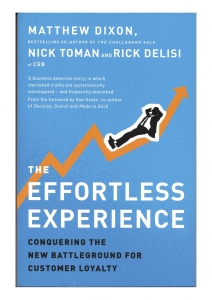The one sentence summary
The idea that delighting customers increases loyalty is wrong – it’s all to do with delivering on basic problems and minimizing customer effort.
WHAT THE BOOK SAYS 
- Everyone knows that the best way to create customer loyalty is with service so good that it surprises and delights. But everyone is wrong.
- All the data in the book comes from a massive survey of nearly 100,000 customers. It asked three questions:
- To what extent does customer service matter in driving customer loyalty?
- What are the things that customer service can do to drive customer loyalty?
- How can customer service improve loyalty, while also reducing operating costs?
- The main findings are:
- A strategy of delight doesn’t pay
- Satisfaction is not a predictor of loyalty
- Customer service interactions tend to drive disloyalty, not loyalty
- The key to mitigating disloyalty is reducing customer effort
- Customers view only 20% of the companies they deal with as unique.
- Loyalty has three types: repurchase, share of wallet, and advocacy. 60-80% of customers who defect were satisfied or very satisfied at the last survey.
- 96% of customers who had high effort experiences were disloyal, but only 9% with low effort ones. So the role of customer service is to reduce customer effort.
- Customers define effort in many ways: taking more than one contact to resolve a problem, generic service, having to repeat information, and being transferred frequently (channel switching).
- Bad word of mouth has additional power. 45% of people with something positive to say about a company tell 3 people. 48% with negative things to say told 10 other people.
WHAT’S GOOD ABOUT IT
- 57% of callers try to solve the problem themselves on the web, and 34% are on the website when they call. This means that many websites aren’t good enough for them to self-serve – they can’t find the information they need, the information is unclear, or they just wanted the phone number.
- FCR = First Contact Resolution. Companies are obsessed with it, but they aren’t measuring it properly. Their data says their FCR is 76%, but customers say it is 40%. This is because there are often unforeseen subsequent problems related to the issue. So the key to stopping these secondary calls is Next Issue Avoidance: anticipating what else might happen after we resolve this issue.
- When it appears that there is nothing we can do, there is actually. This is experience engineering, and includes understanding the distinction between what customers have to do (78% of companies focus on this), and how they feel after the interaction (only 27% of companies concentrate on this). Advocacy, positive language, and anchoring expectations all help here – it all adds up to alternative positioning of the response.
- Overall, make it easy for customers to navigate information, provide information that is jargon-free and trustworthy, and make it simple for them to weigh up their options.
WHAT YOU HAVE TO WATCH
- The book slows down a bit at the end, but the main findings are fascinating.
